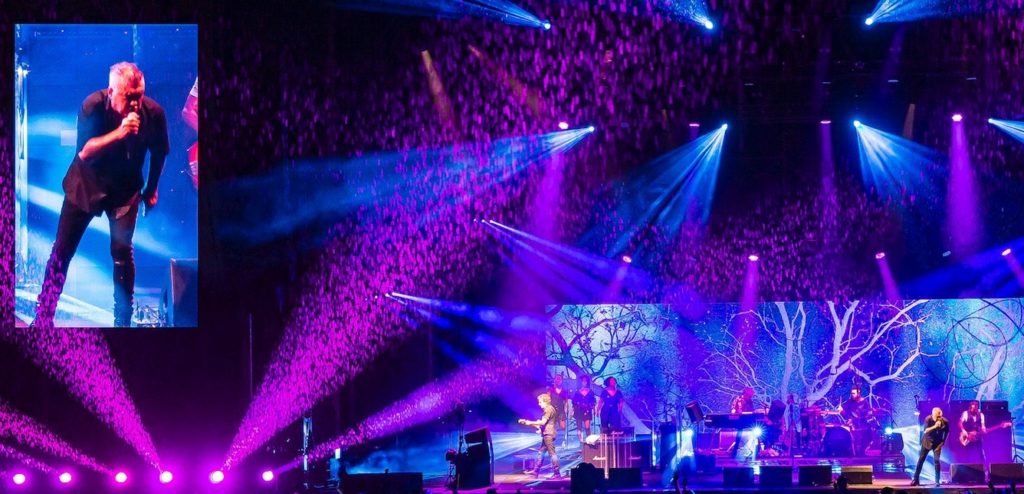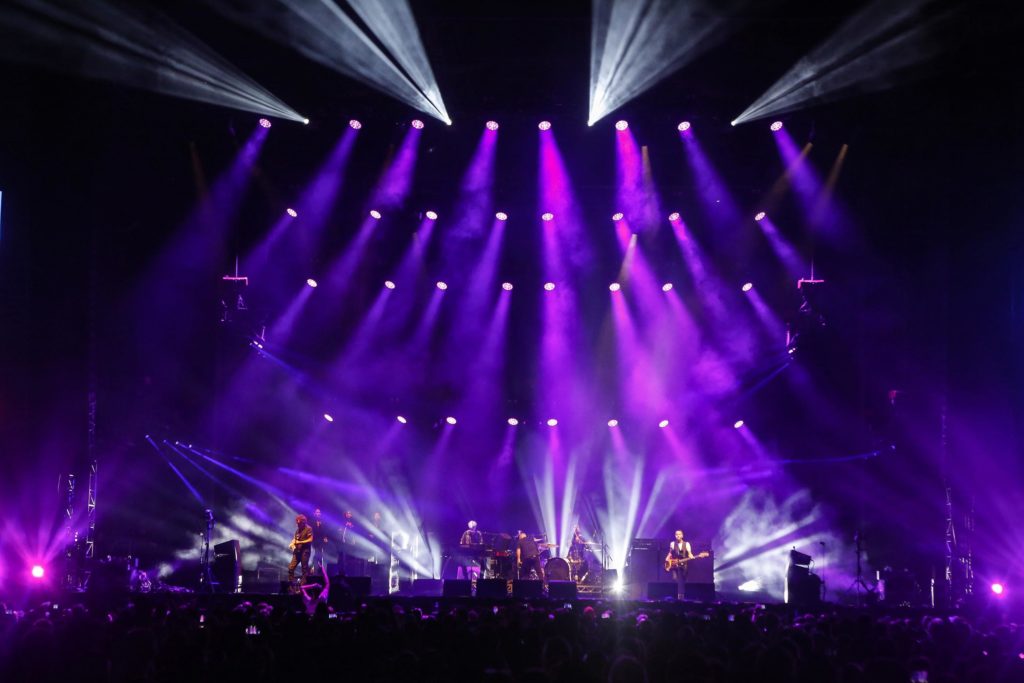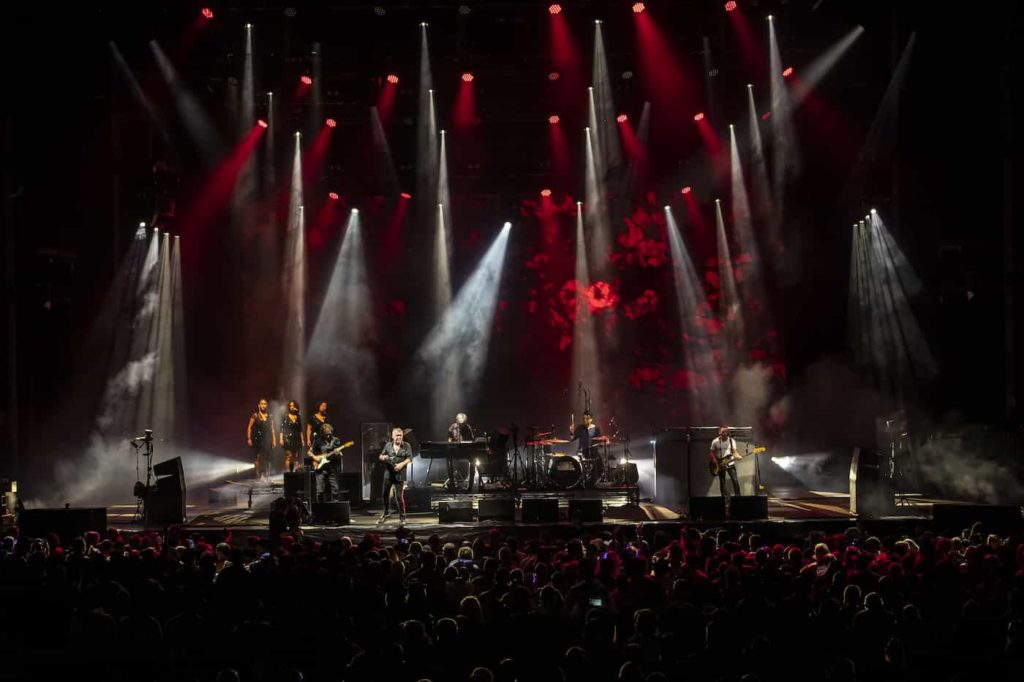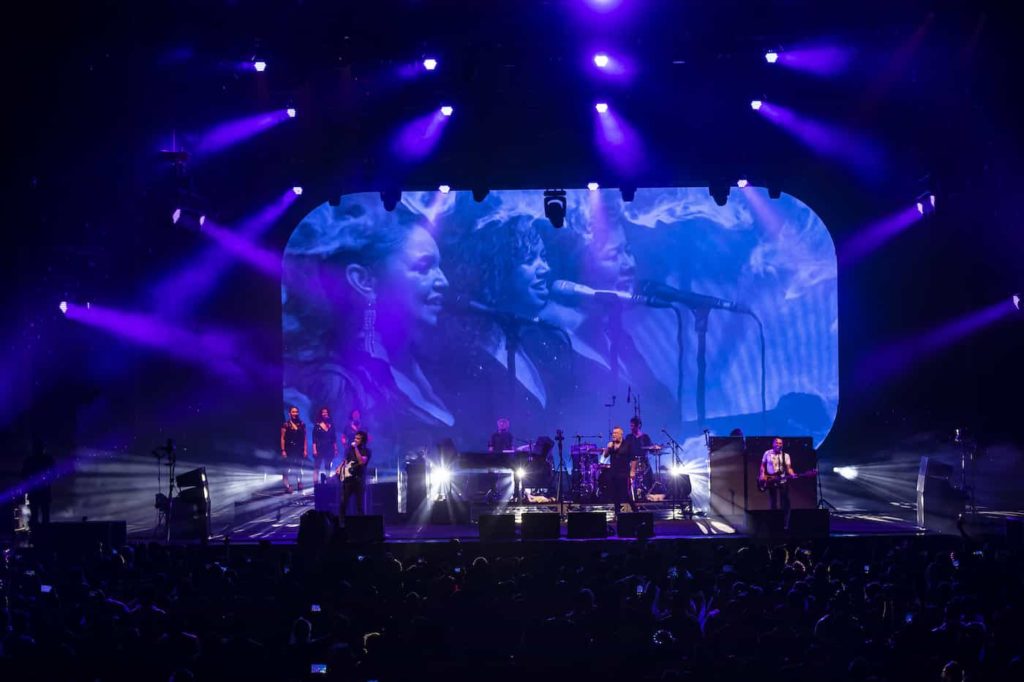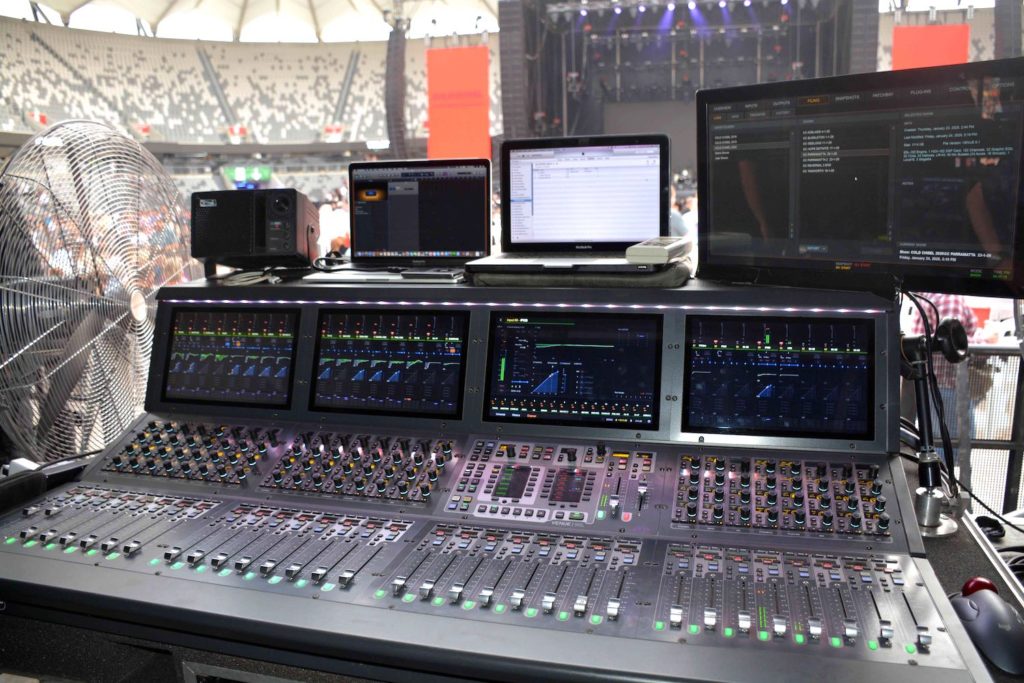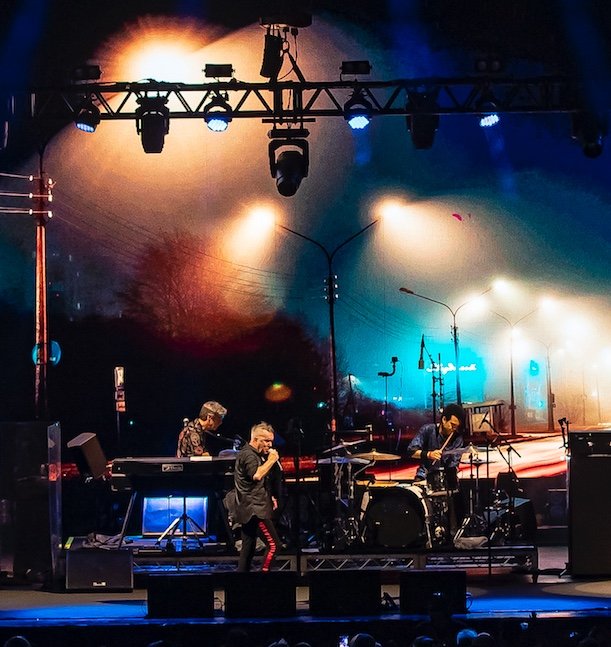News
16 Mar 2020
Cold Chisel

Subscribe to CX E-News
Troy Cassar-Daley has an aboriginal name for Jimmy Barnes that means ‘rain man’, however on Cold Chisel’s recent Blood Moon tour Mother Nature threw more than that!
“I knew that we would be breaking the drought when the band decided to do 25 outdoor shows!” commented lighting designer Jeff Pavey.
“It was not only the end of the drought – we had fires, smoke cancellation, emergency trucking, flooding and trucks trapped in WA. The rain hammered us in Victoria, Hunter Valley and particularly in Brisbane.
“Every single show had major weather or fire elements to it. I think Orange was the only show where it didn’t rain however it was a 45°C dust bowl. I’ve never seen anything like it; it was like concrete dust, really fine and 15,000 punters were kicking it up.
“Plus, as it was so hot, there were no sides on the FOH so the gear got covered in dust and had to be sent away for cleaning straight afterwards.”
Despite all of this, only one show was cancelled, A Day on the Green at All Saints Estate Wine Rutherglen, where the environmental situation and air quality was extremely poor.
The Canberra show was lucky to go ahead as the fires were less than five kilometres away.
“On the setup day we had to leave at about 4 PM as the smoke was so bad at the site,” added Jeff.
The Canberra show was lucky to go ahead as the fires were less than five kilometres away
For the first time in fifteen years, the band decided to incorporate a video element: DiColor LED all housed in touring frames and a PTZ camera package for the touring production as well as additional camera packages for the venues requiring IMAG screens.
“I think it was just to do something a bit different as the last three tours were very rock’n’roll with a big wall of lights as that’s what they really like,” said Jeff.
“These were supposedly the last ever Chisel shows so they wanted to go out with a big bang.”
Jeff decided to hang the IMAG screens in portrait mode, saying he simply prefers it after experimenting at Splendour in the Grass and that he feels it looks bigger for the whole show.
Also, portrait mode is Day on the Green’s preference and they supply the screens on their shows, so it was a happy medium. After all, why have a 6ft high Jimmy when you can have a 20ft high Jimmy!
Video Content Director Rachael Johnston’s brief was simply to put together a set of visuals that would be ‘interesting and supportive without being distracting.’ Consequently, she set about creating visuals that the core Chisel audience could relate to while still being innovative.
“I spent a considerable amount of time just researching everything about the band,” commented Rachael.
“Throughout their career, they’ve had a very strong, consistent aesthetic. I wanted to stay true to that, while also creating a video show that looked visually appealing when transformed to the stage with Jeff’s lighting design.
From this research, I created a video deck for the band. They were really happy with most of it – they made a couple of requests based on personal connections to specific songs, and it all went from there.”
The imagery used consisted of all custom content, using a lot of what Rachael calls ‘Cold Chisel red’ throughout the show.
A number of concepts that she had in mind would require a film shoot, so she contacted her good friend Brandon Specht, who is an action vehicle coordinator; he jumped on board as assistant director for a day.
“We secured a ‘70s Dodge Charger, some cameras and a drone and went out to some farmland near the Gold Coast,” explained Rachael.
“Miraculously the Charger’s owner let us take it into a really dusty field to get some overhead shots of it doing donuts. We got some great drone and wheel-mounted footage which I ended up using for the song Houndog.”
These were supposedly the last ever Chisel shows so they wanted to go out with a big bang
“We also shot footage for Killing Time, which has become a particular favourite of mine.
“As this was a new song I didn’t know much about the background, but the music and lyrics conveyed to me a dark, desperate crime scene. Cold Chisel has featured this content in the Killing Time film clip released recently, which I’m really happy about.”
For Breakfast at Sweethearts Rachael wanted to convey that raw King’s Cross life in the ‘70s as King’s Cross is really central to Chisel’s early days.
The photographer Rennie Ellis got some incredible shots of locals in the Cross during the ‘70s, and she thought they would be perfect. She approached the Rennie Ellis Photographic Archive, who kindly licensed Rennie’s King’s Cross collection.
“I was really pleased to be working with Jeff again for this show,” Rachael said. “He worked brilliantly to colour match the lights to the visuals.
“I particularly loved the overall scene that Jeff and I worked on for Four Walls. We created a theatrical ‘prison’ on stage—a still image of a brick wall which I had graded, with Jeff pointing non-moving lights from the ceiling vertically downward to create a prison bar effect – simple and very effective.”
Rachael used live camera for a few of the songs, applying a creative treatment in order to match the lights and the general Cold Chisel aesthetic.
For Getting the Band Back Together and Cheap Wine, a five-way camera split was created, so they were able to show each band member on screen at the same time.
“I operated all the visuals live using Resolume visual software and Creative Lighting supplied the LED screen,” added Rachael.
“For the five-way camera split, I had the brilliant Shane Budini helping me with four PTZ cameras on stage, and I used the main camera feed from the IMAG for the fifth camera.
“We put these signals into an eight-way quad preview splitter, usually used for previewing cameras.
“I ingested these signals and then cropped and positioned within the video raster, often adding a creative frame or treatment to keep it interesting and matched to the lights.”
Having worked together with Powderfinger over ten years, Rachael and Jeff already had a solid understanding of each other and enjoyed working together again.
“With the video at the back it’s always good to have something that you can complement although it’s a totally different dynamic to doing a big rock show where it’s all about lights,” said Jeff.
“All I’m really doing in a lot of the show is framing the video, complementing what’s already there. Having said that, there are of course some big lighting accents too.”
The lighting rig had to be restricted in size due to truck space as there were only four trucks in use whilst Elton John who was playing the same venues had 38 trucks.

Only one truck was for lighting so fixtures were chosen for their power and versatility and were all pre-rigged so the rig was up in a couple of hours. Jeff is very proud of the fact that after 25 shows, all in horrendous weather, not one light went down.
The Robe MegaPointe is currently Jeff’s favourite fixture and so it was no surprise to see forty of them all over the rig.
The three above stage trusses and the front truss had them interspersed with GLP X4 LED Wash, a total of 32, whilst two side trusses per side saw them sharing with a total of eight GLP X4L LED Wash.
Eight more were located at the rear of the stage on the floor along with lots of Molefays. In fact, the rig was littered with 44 Molefay 2 Lite DWE and 13 Molefay 4 Lite LED.
“I’m a big fan of side lighting, in fact, I can’t do a show without it!” said Jeff. “I’d prefer to have side lighting any day over backlighting, it just adds so much depth and gives you something in all of the shots.”
Out on the wings were 16 LightSky Aqua Beams helping to add width to the stage and chosen by Jeff for their brightness, in fact, Jeff says they are just as bright as the MegaPointes.
Only one truck was for lighting so fixtures were chosen for their power and versatility and were all pre-rigged so the rig was up in a couple of hours
On the front truss were six BMFL Beam Wash with two more on the first mid truss and three on the rear truss.
Jeff used the Follow Me remote follow spot control and automatic performer tracking system with the BMFL Beam Wash, a fixture he likes for its good intensity and nice texture.]
“It’s my new little toy and I love it,” he said.
“I’ll never go back to using followspots. Outdoors it’s a little tough because you can only hang the front truss a certain distance from the downstage edge as opposed to being in an arena and having it halfway down the room.
“But I just love that you don’t have all the overthrow from a followspot, cutting through into other people. It was choppy in the stadium but it really made the performers pop out as the beam was really tight.”
Jeff loves his smoke and although some of the gigs had plenty of natural smoke, he still toured four MDG HO Stadium Hazers and three Look Solutions Unique Vipers.
“I have to say the Aqua Beams’ light fans on the wings looked amazing in Orange’s dust, you couldn’t have hoped for a better look!” said Jeff.
“I’d rather have six smoke machines on tour and keep two in the truck for backup because smoke is such an important part of the show. It’s stupid to have a million-dollar light show and have $50 worth of smoke as nothing reaches its full potential.”
Jeff ran a High End Systems Hog 4 for control saying he’s too old to learn an MA platform! “I’m very happy with the Hog 4 and refuse to learn how to even patch an MA!” he laughed. “It’s got me to where I am for the last 45 years.”
AUDIO
Cold Chisel was the first act to play at Parramatta’s new BankWest Stadium and Colin Ellis, their sound engineer, was impressed by this new venue, saying he was surprised at just how good it was.
“I was expecting all the overhanging roofs to slap everything like at the MCG where you hear the snare drum about ten times like a shotgun!” he said.
“But BankWest Stadium has a curvature in the roof and openings that seem to capture the sound and push it out of the stadium rather than reflect it.
“One of the crew said he was out in the carpark when he heard a loud clanging noise as if someone was hitting steel right beside him. He couldn’t see anyone and eventually he realized it was coming from within the Stadium!”
Not surprisingly, Colin was concerned they may get hammered by the EPA but he didn’t see any EPA presence at the gig. That probably won’t become the normal!
Colin specified an L-Acoustics K1/K2 PA system from tour provider JPJ Audio, admitting it was basically the same PA setup as he recently used for Midnight Oil.
“The main hangs were mostly K1 with K2 on the bottom for wider dispersion and the side hangs were K2,” he said.
“The delays have varied but at BankWest stadium JPJ implemented a ring delay of K1 suspended from the stadium roof rather than traditional delay towers which would have obscured the view for some of the audience.

“The reports that I heard from up in the grandstand sections were really positive. I think if there were any weaknesses it was behind the mix position back to the grandstand seating where it got a bit echo-ey.
“As usual, the JPJ crew have been great and have really looked after me. They work so hard to ensure everyone is happy.”
FOH, Colin mixed on an Avid VENUE S6L utilising only a couple of onboard plugins. An Avid Profile is used FOH for the support acts, and as a backup if something tragic was to happen to the S6L.
Colin admits that mixing for Cold Chisel can be tricky, especially as they don’t soundcheck. “I do record with ProTools and then run Virtual Soundcheck just to get a start however it’s not that successful,” he added.
“Every time you do it, you think that sounds great and then when the band comes out it’s completely different. It never seems to sound anything like the Virtual Soundcheck does!
“To be honest, it’s always a bit of a scramble at the beginning of the show but the good thing about Chisel is they always come together.”
The Yamaha CP70 electric piano often causes Colin grief as it tends to feedback a little with the bottom end. “You have to be careful with the low end coming off the PA getting into the piano and feeding back on you,” explained Colin.
To be honest, it’s always a bit of a scramble at the beginning of the show but the good thing about Chisel is they always come together
“That’s the main problem we’ve had trying to get a sub configuration and sub tuning that works for me yet doesn’t upset the band.”
Colin states that he doesn’t have to do anything special for Jimmy’s vocal, he just lets him go for it. “It’s a rollercoaster ride but he’s good!” he laughed.
“When he’s on fire he’s astounding. I try to get a good solid mix and then punch up whoever is doing a solo to get them over the top.
“I like to get Ian’s guitar over the top of everything because he’s one of the few guitar players I’ve worked with you can actually do that and get away with it.
“A lot of people come to see him play so it’s a big part of the show.”
The band used Shure SM58 mics with the backup singers on SM89. Kez Kesby ran monitors on a DiGiCo SD5.
CX Magazine – March 2020
LIGHTING | AUDIO | VIDEO | STAGING | INTEGRATION

Entertainment technology news and issues for Australia and New Zealand
– in print and free online www.cxnetwork.com.au
© VCS Creative Publishing
Subscribe
Published monthly since 1991, our famous AV industry magazine is free for download or pay for print. Subscribers also receive CX News, our free weekly email with the latest industry news and jobs.




